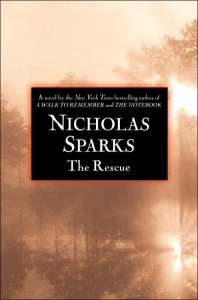Nicholas Sparks
The Rescue

Grand Central Publishing 2005
“PG-13”
339 pages
Fiction
Summary:
Denise Holten is all alone in a small town… Except for the company of her five year old son, Kyle. Kyle has a speaking/communication disorder that has caused Denise, a former elementary teacher, to stay at home to help him learn. She lives in a home she inherited in the town her mother grew up in, though she doesn’t know a soul. One fateful night a car accident turns her world upside down. Denise is knocked unconscious and her son, terrified of the storm raging around him, wanders off, trying to escape the weather. Unfortunately, he wanders off into a swamp. Fortunately, he was found several hours later, completely unharmed, thanks to Taylor McAden. Taylor volunteers for the local fire department, and has a particularly keen tracking ability. Denise feels gratitude towards Taylor, but she also feels something more… Sparks fly. He is patient with Kyle, kind, and a genuinely good man. Denise loves Taylor, Kyle loves Taylor, and Taylor loves Denise, but Taylor is dealing with guilt from his past. Denise attempts to break through those thick outer layers to find out what it is that is holding Taylor back emotionally. After a few twists and turns, their relationship is put to the test. Will it survive?
Your Reaction: Pleasantly surprised. Though I thought it was a little slow to start, I found it sucked me in. I have only read a couple Nicholas Sparks books (The Notebook and The Wedding), but I thought it stacked up pretty well to the other books (and the many movies).
Potential Problems: Minimal language issues. No “F” bombs. Sexual content. Not graphic. If you are okay to watch a Nicholas Sparks movie than you are probably okay to read the book.
Recommendations: I would be more likely to recommend this to friends my age or older. Not really for students… But many 9th grade girls are big Nicholas Sparks readers. They are definitely less smutty than other “romance” choices, so if you want to read romance this is a good PG-13 choice.
If you want to read “romance” but this isn’t appropriate for you.. If I remember correctly, Lurlene McDaniel was a popular choice when I was in jr. high and I think it may have been more “PG” rated. They also typically feature someone fighting a major illness.
